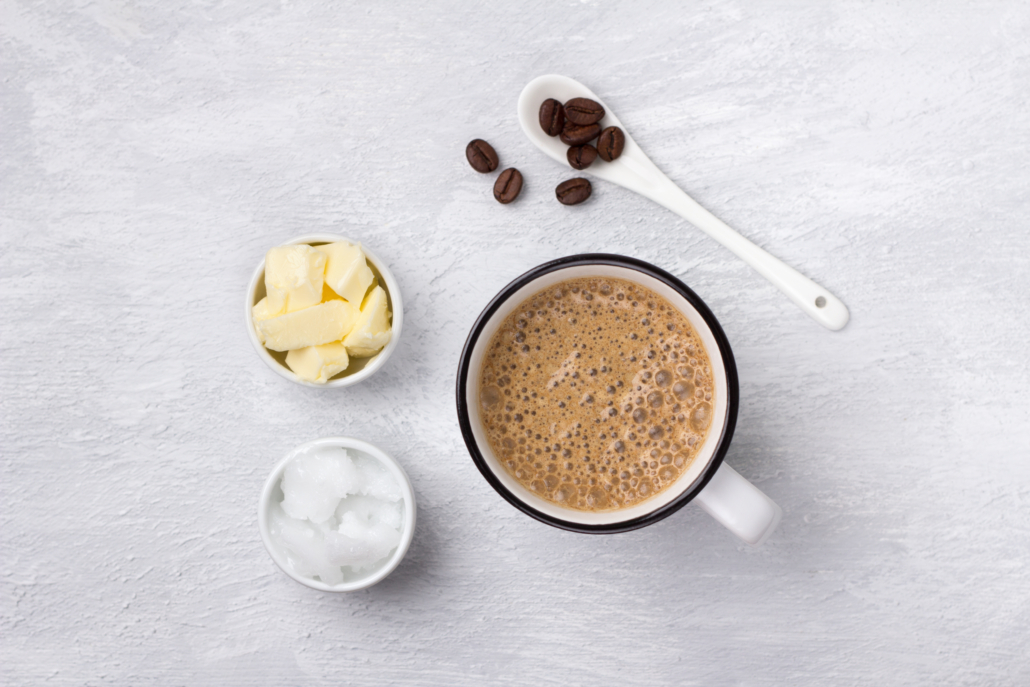We include products in articles we think are useful for our readers. If you buy products or services through links on our website, we may earn a small commission.
The Ketogenic Diet: Beginners Guide to the Keto Lifestyle
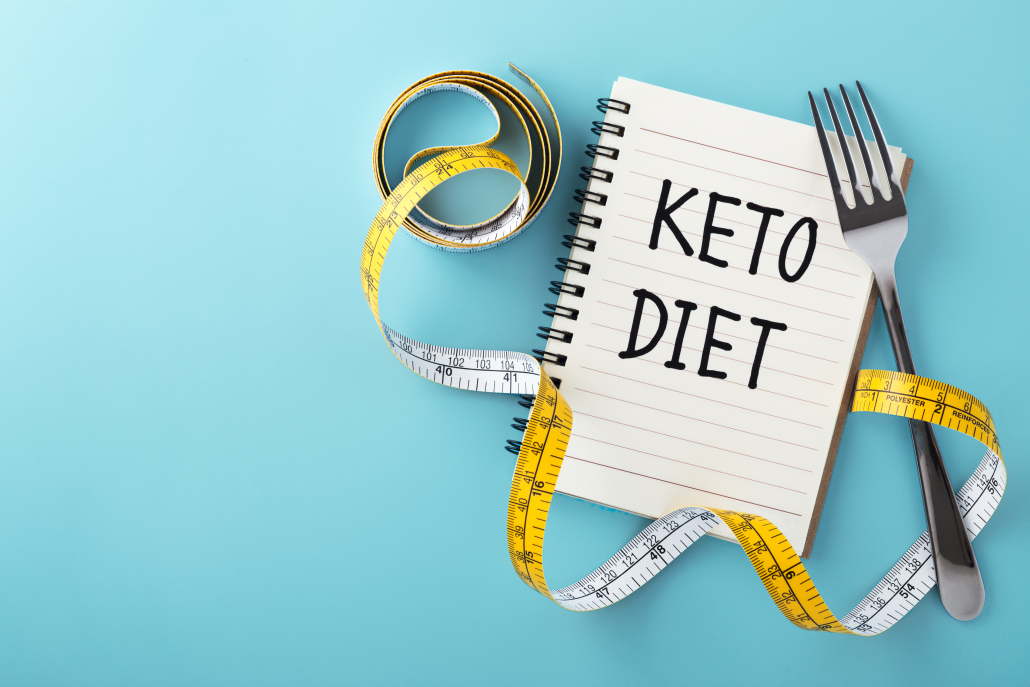
The ketogenic diet is a low-carb high-fat way of eating that offers numerous health benefits.
Many people think of the ketogenic diet as a way to lose weight . But most people are unaware that a keto diet can be used to treat many other chronic and serious health issues.
Ketogenic diets have been in use for over 100 years to treat epilepsy. And research over the last ten to fifteen years has shown ketogenic diets are also effective for the treatment of cancer , neurological diseases such as Alzheimer’s , type 1 and type 2 diabetes, insulin resistance and cardiovascular disease.
This detailed beginner’s guide to the ketogenic diet has everything you need to get started today.
Table of Contents
The Ketogenic Diet Explained
A ketogenic diet limits carbohydrate intake to less than 60 grams per day while allowing adequate amounts of protein and a higher fat intake.
In contrast, the standard American diet is high in starch and sugar, with the average American consuming about 50% of calories from carbohydrates. This works out to 235 grams of carbohydrate per day on a 2000 calorie diet.
Though there are various types of ketogenic diets, the macronutrient ratios for a standard ketogenic diet fall within these ranges:
- 70-80% of calories from fat
- 15-30% calories from protein
- 0-10% calories from carbohydrate
Keto Changes Your Metabolism
Biochemically speaking, ketogenic diets create a revolutionary change to your metabolism. Dramatically reducing carbohydrates results in a reduction in the amount of blood sugar available for use within the body.
Reduced blood sugar forces cells to abandon sugar (glucose) as a primary source of energy. Instead, stored fat, dietary fat, and fat-burning byproducts called ketones become the primary fuels.
This metabolic change to using fat and ketones as energy is known as “being in ketosis” and it is a powerful metabolic tool.
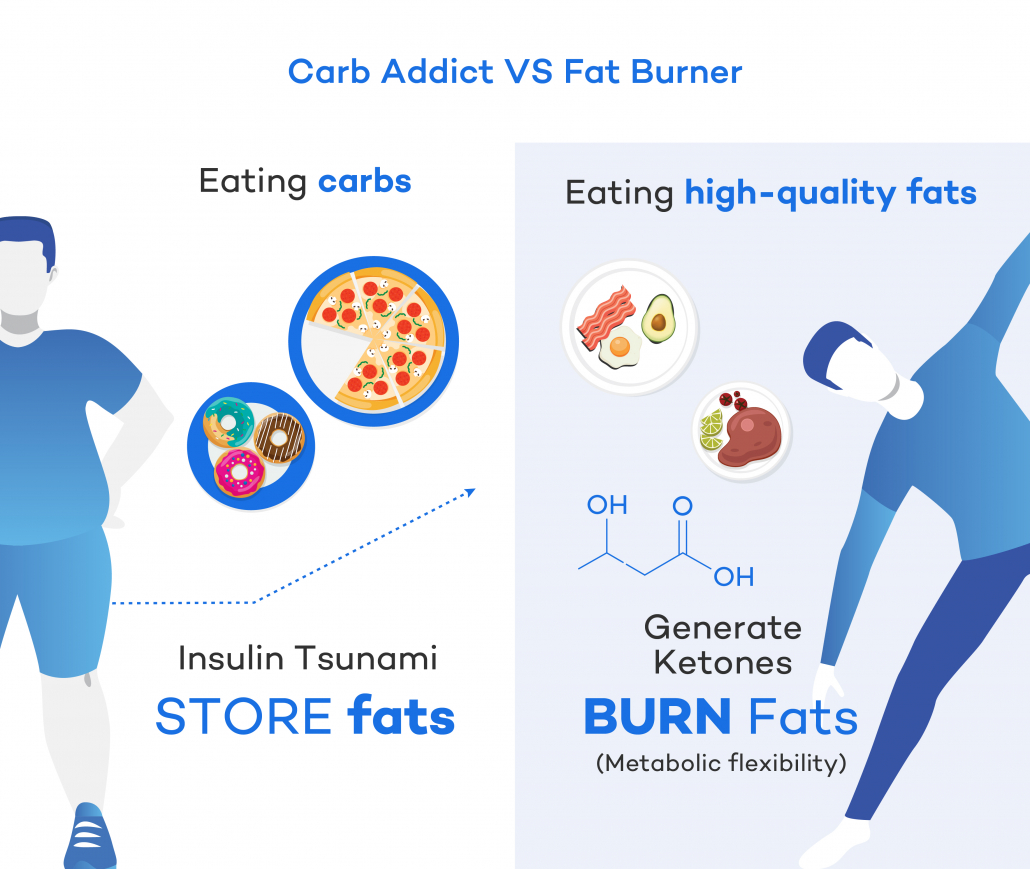
Keto Diet Fast Facts
- Any diet that causes the production of ketone molecules (ketogenesis) within the body qualifies as ketogenic.
- Fasting, very-low calorie diets, and a lower carbohydrate intake will all result in ketogenesis.
- Ketogenesis is the process where fat stored on your body, and from the food you eat is converted into energy molecules called ketones.
- On a ketogenic diet you can eat satisfying proteins in the form of eggs, meat, seafood and poultry, natural fats such as butter and olive oil, and leafy, non-starchy vegetables.
- All high-carb foods are off the table. This includes pasta, bread, crackers, tortillas, pretzels, cookies, cereal, cake, pies, candy and corn, beans, and any kind of potatoes or other vegetable high in carbohydrates.
- Many of the health benefits of a keto diet are linked to how it lowers blood sugar and insulin levels.
- Lower blood sugar and insulin supports the health of your glycocalyx, while reducing glycation damage, inflammation, and insulin resistance. These are all underlying factors in many chronic diseases.

What is Ketosis?
Ketosis is easiest to explain from a view of how cells in the human body make energy. Our main cellular energy sources derive from either:
- Sugar (glucose) from various sources (dietary carbohydrates, or the breakdown of protein or glycogen stores in muscle and liver)
- Fats, either stored as fatty acids or from dietary intake
Since your body’s ability to store carbohydrates is limited , fasting or a lack of dietary carbohydrate will deplete this reservoir within a day or two.
When carb intake is reduced and body stores are depleted, blood sugar and insulin levels will fall. Energy from stored or consumed fatty acids begin to flow into the bloodstream and accumulate.
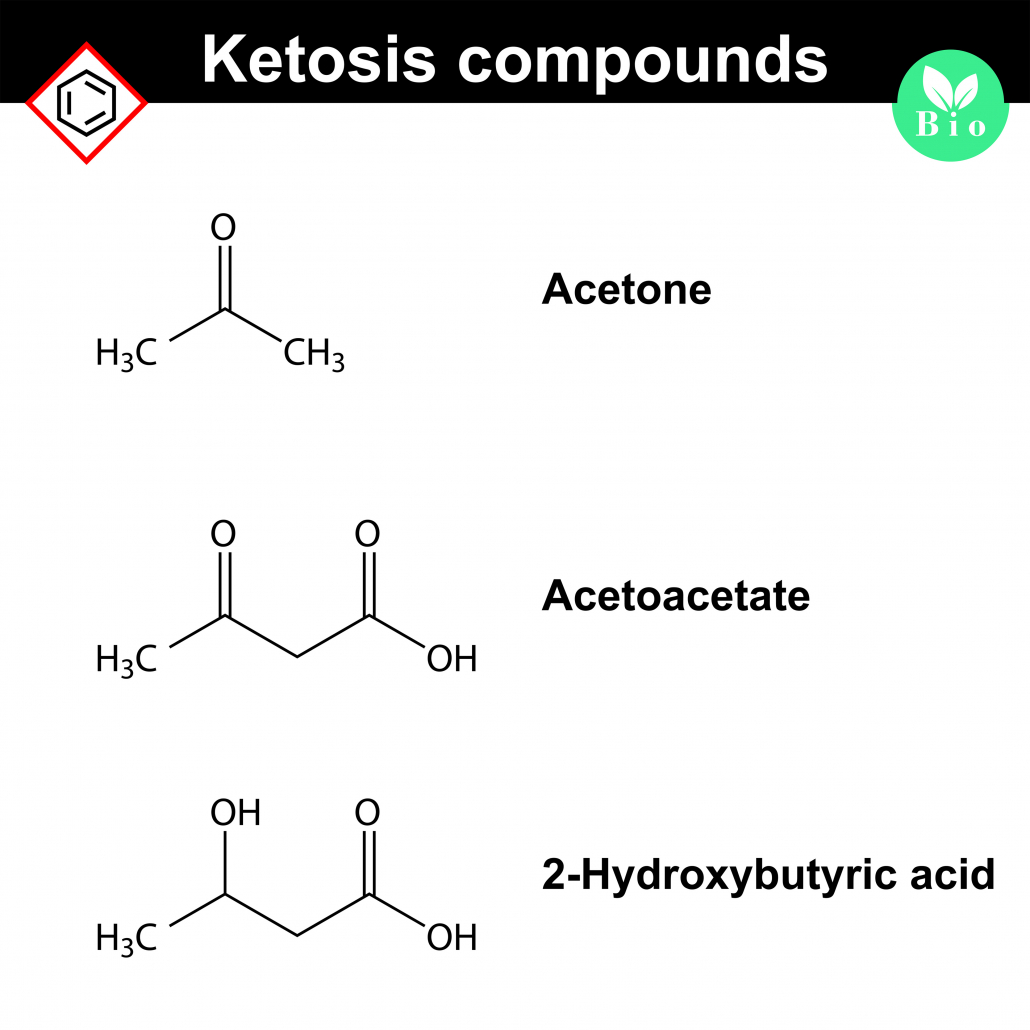
Over time, the level of fatty acids in the blood rises to a point at which specific enzymes in the liver convert some of these fat-derived molecules into ketone bodies. This process is called ketogenesis. The body state when ketogenesis is providing the primary fuel source is called ketosis.
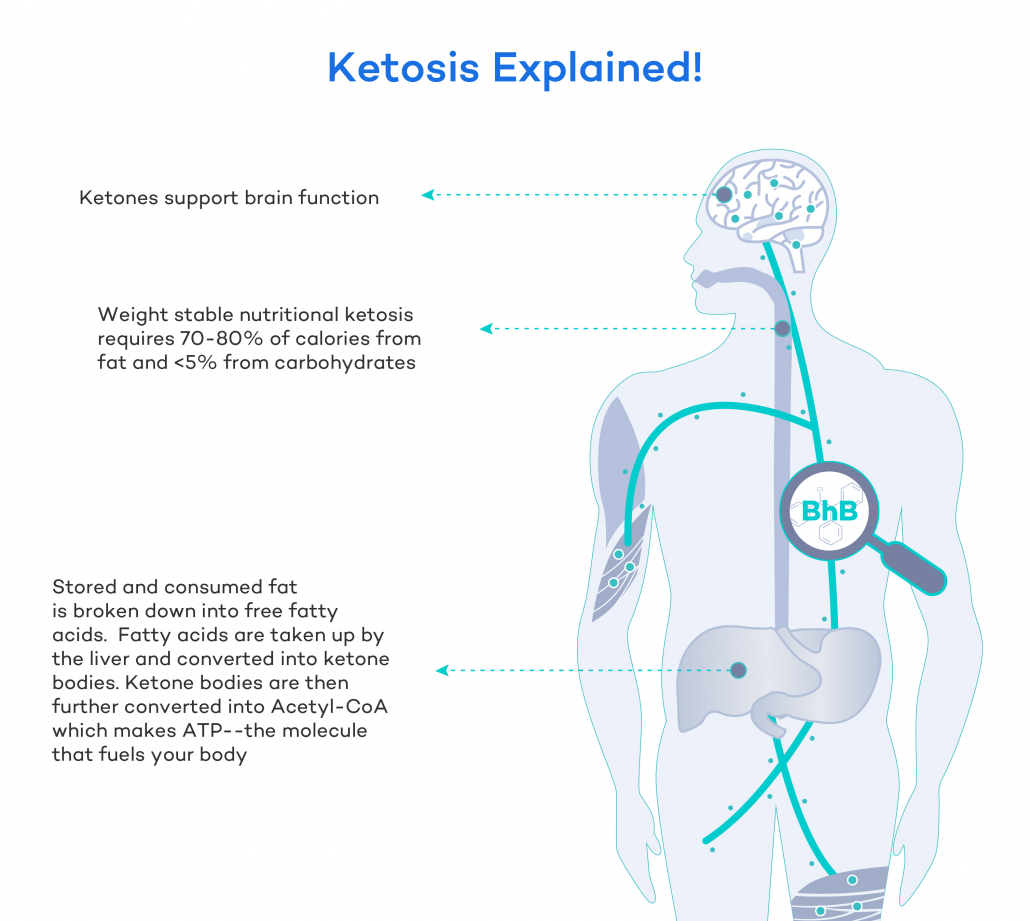
Types of Keto Diets
There are several different versions of ketogenic diets in use today. Each is tailored to a variety of therapeutic, nutritional, athletic, and ethical goals.
The Classical Ketogenic Diet
Way back in 1921, Dr. Russell Wilder applied his knowledge of ketone production during fasting and designed what is now called the classical ketogenic diet. In 1923, the diet was put into clinical practice in the treatment of epilepsy at the Mayo Clinic.
This classical ketogenic diet consisted of a 4:1 ratio of macronutrients, or 4 grams of fat to 1 gram of protein plus carbohydrate. This worked well to calm seizures but was impractical to implement in some cases.
Since then, more moderate ketogenic diets such as the MCT diet, and the 2003 modified Atkins diet have been developed for use in treating epilepsy. These innovations come out of the extensive body of research and clinical experience using the classical ketogenic diet,[18] by modern clinician-researchers such as Dr. Eric Kossoff at Johns Hopkins Hospital.
The Dr. Atkins Ketogenic Diet
A more accessible version of the ketogenic diet went public in 1972, when Dr. Robert Atkins published his book, Dr. Atkins Diet Revolution.
Dr. Atkins wrote the book after experiencing the benefits of carbohydrate restriction himself. The book counsels followers to maintain a carbohydrate intake of less than 20 grams per day for the first two weeks of the diet.
After this first ketogenic phase, dieters can begin adding 5 grams of carbohydrate a week to their daily totals (for example, 25 grams a day the third week) and to repeat this method weekly until their weight loss stops. At this point, they are said to have found their level of “carbohydrate tolerance”.
Once a person reaches their weight goal, they enter what’s called “phase 3 maintenance.” The diet is now less ketogenic and more low-carb, depending on the person.
The Standard Ketogenic Diet
Today, the “standard” ketogenic diet is defined in terms of macro percentages, with 70%-80% of calories coming from fat, 20%-15% from protein, and 5-10% from carbs.
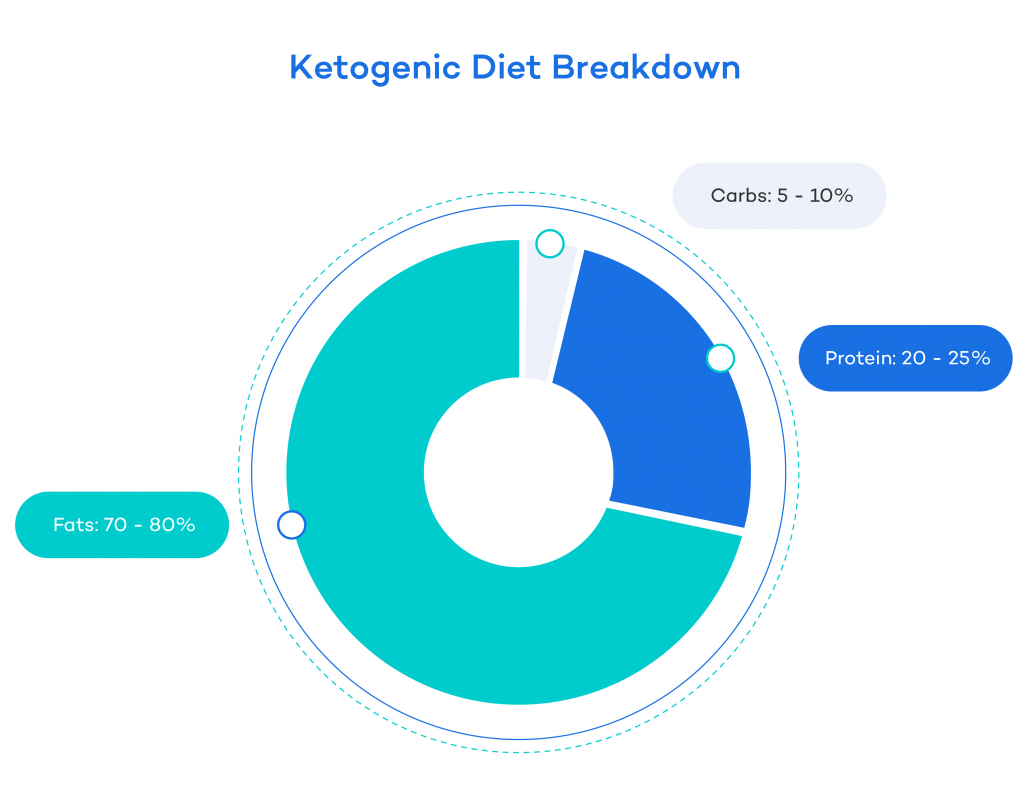
This macronutrient ratio works for most average-sized people doing average amounts of exercise. However, small women, very large men, and athletes may find that these ratios need to be adjusted to provide the proper amounts of protein to support lean body mass, and fat to stay in ketosis.
Higher Protein Ketogenic Diet
Some physicians familiar with ketogenic diets counsel that for weight loss, a “high-protein” version is better. This version sets the percentage of calories consumed from fat at around 55-60%, increases protein intake to about 35-40% of calories and lowers carb intake to 5%.
In addition, other versions of ketogenic diets have been designed by groups and individuals with various goals. For instance, in the research literature, definitions of keto vary, with some studies calling their version “very-low-carb-ketogenic-diet (VLCKD) or low-carb, high-fat (LCHF).
Athletic Versions: Targeted and Cyclical
Newer versions of the ketogenic diet are often tailored to athletic needs. For instance, one “targeted” version provides for more carbohydrate intake before and after exercise. This athletic version is purely anecdotal, and no research has been done on these so-called, “targeted ketogenic diets”.
Other athletic versions call for lower fat and higher protein intakes, and cycling of carbohydrate intake.
For example, the cyclical ketogenic diet (CKD) was designed by and for bodybuilders to maximize fat loss and muscle growth. This version consists of cycling periods of low-carb, high-protein, and high-fat eating days with contrasting days of high-carb, high-protein, and low-fat meals.
Followers say the CKD maximizes blood levels of testosterone, growth hormone, and insulin-like growth factor 1, which results in muscle growth.
The research on this diet is scanty, but there is one study that defines CKD as being five weekdays of ketogenic eating allowing less than 30 carbs per day, followed by a “carb supercompensation” period on weekend days.
The Carnivore Diet
One of the most recent evolutions of the ketogenic diet is the carnivore diet. Though new to modern Western culture, the carnivore diet is linked to ancestral eating habits.
The parameters for this diet include eating only animal-derived protein, such as meat, fish, poultry, and eggs.
Cheese and other dairy products can be included but are discouraged if weight loss is a goal. Protein and fat percentages are close to the standard ketogenic diet, while carbohydrate intake drops to almost zero.
On the carnivore diet, many of the vitamins and minerals that people get from plant sources are satisfied in greater quantities, and more bioavailable varieties from nutrient packed organ meats.
The following image shows an example of the carnivore diet meal plan.
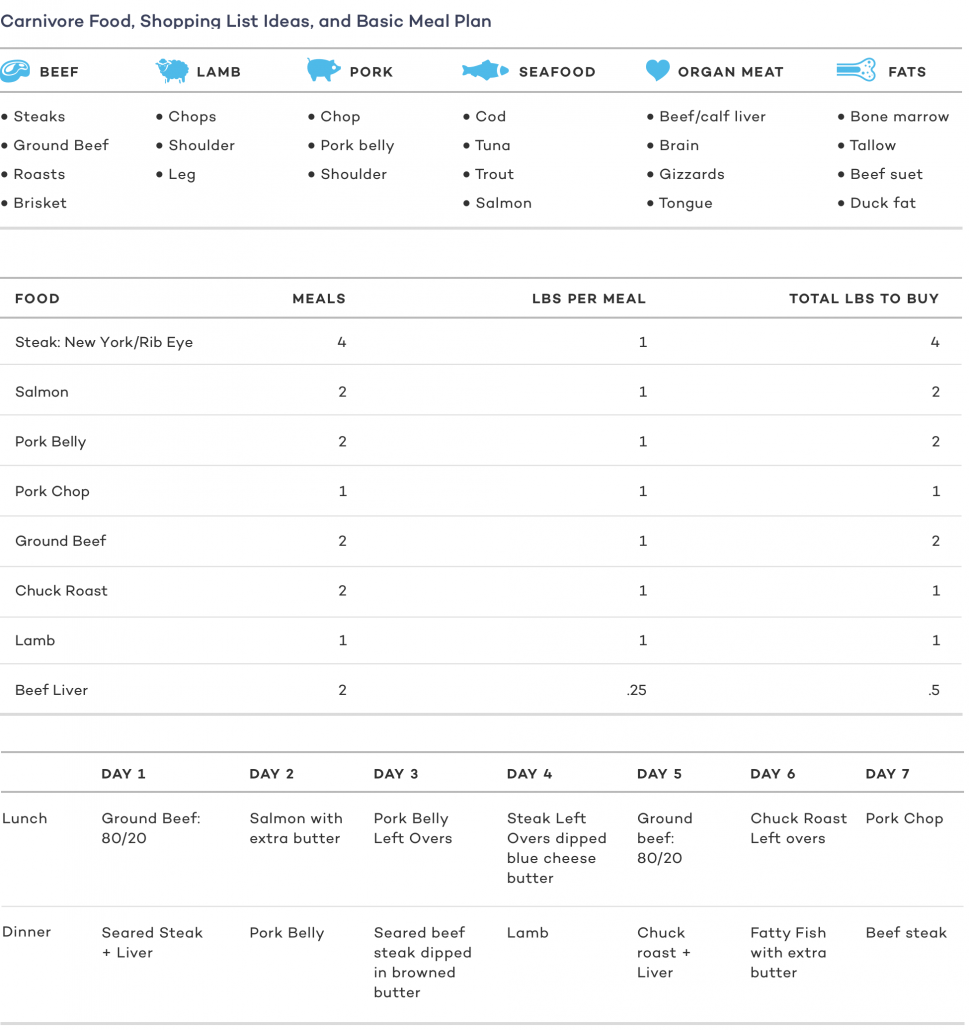
The Protein-Sparing Modified Fast
The protein-sparing modified fast (PSMF). This type of ketogenic diet is designed by physicians to mitigate the physiological harm associated with protein-malnutrition in acute illness,[24] and to safely maximize weight loss for morbidly obese and/or diabetic patients.
The Cleveland Clinic defines this diet as extremely low in calories, carbohydrates, and fat, and high in lean protein, which minimizes the protein loss associated with the lowered calorie and carb intake.[25] Basically, the PSMF is a standard ketogenic diet without most of the fat.
Keto for Vegetarians
The vegetarian keto diet is an eating plan that combines aspects of vegetarianism with the keto emphasis on low-carbs, high-fat, and moderate-protein. Vegetarians practicing keto follow the same macro and micronutrient proportions as you would on a standard keto diet.
The more liberal the type of vegetarian you are, the easier it will be to adopt a high-fat low-carb lifestyle.
For a guide to keto for vegetarians complete with food lists and meal plans, click here
Keto for Vegans
A vegan keto diet maintains the same macro and micronutrient breakdowns as a standard keto diet, but eliminates all animal derived foods including eggs and dairy.
This diet will require additional supplementation in order to get adequate amounts all essential fats, and all 9 essential amino acids (complete proteins). In the world of nutrition “essential” means that our bodies cannot produce it on our own, so we have to get it from the foods we eat.
Only animal foods provide all the essential fats and amino acids in near perfect-proportions for humans. Most plants lack one or more of them.
However, a well-planned and supplemented vegan keto diet based on whole, unprocessed plant foods makes it possible for vegans to receive many of the same benefits of standard keto diets.
To learn more, click here for our ultimate vegan keto diet guide.
Keto For Weight Loss
The successful use of a ketogenic diet for weight loss is backed up by a deluge of anecdotal evidence, but a large body of formal research literature exists to support this choice as well.
One 6-month trial looked at using a very-low carbohydrate (VLCD) diet versus a calorie-restricted low-fat (CRLF) diet to promote weight loss in healthy, obese women. The results showed a significant difference, with the group following the VLCD losing not only twice as much weight, but more body fat as well, even though both groups ate the same number of calories per day (around 1650).
A longer study reported in the New England Journal of Medicine compared a Mediterranean diet, a low-fat diet, and a low-carbohydrate diet for weight loss over a 2-year period. Participants in the low-carb diet group again lost the most weight, even though they were allowed to increase their carb intake from a start of 20 grams to 120 grams per day at the end of the study.
It is interesting to note that neither the Mediterranean nor the low-fat group were allowed to increase fat consumption. One wonders how much more weight the low-carb group might have lost had they stayed under 50 carbs per day for the duration of the study.
The results of these two studies clearly show that ketogenic diets, and even relaxed low-carb diets are excellent choices when pursuing weight loss goals.
Keto for Diabetes and Pre-Diabetes
The ketogenic diet is also the best choice for treating the progressive conditions of pre-diabetes, metabolic syndrome, and full-blown diabetes due to its robust blood-sugar lowering effect.
Before 2018, the American Diabetes Association had been reluctant to acknowledge the low-carb diet’s treatment efficacy. This delay occurred in spite of strong studies showing that low carbohydrate diets are much more effective in treating prediabetes and diabetes than any other diet.
Fortunately, in 2019 the ADA released a Consensus Report on diabetic nutrition therapy that finally admits that low carbohydrate diets are effective for improving blood sugars.
Other Benefits of the Ketogenic Diet
Globally, 3 out of 5 people die from chronic inflammatory diseases including many that a ketogenic diet has been shown effective against.
Heart Disease
A keto diet has been shown to improve cholesterol levels by reducinc circulating triglyceride levels and increasing HDL (good) cholesterol. This results in an improved triglyceride to HDL ratio. A high triglyceride to HDL ratio is a strong predictor of extensive heart disease.
A 2013 analysis of 12 high quality studies involving more than 1200 participants investigating the impact of very-low-carbohydrate ketogenic diets vs. low fat diets, found that the average increase in HDL particles in the low carb group was double that of the low fat group.
Cancer
Most cancer cells can only burn glucose as a fuel source. They are unable to burn ketones or fatty acids, which most other healthy cells can do. When glucose availability is restricted, as it is on a keto diet, the metabolic environment created makes it more difficult for cancer cells to survive and grow.
Numerous recent studies have been done to deepen our understanding of keto as a tool for fighting cancer.
Neurodegenerative Diseases
Given the keto diet’s efficacy in treating epilepsy, researchers have also been studying it for treating Parkinson’s disease, Alzheimer’s disease, and amyotrophic lateral sclerosis (ALS).[37]
Studies show that keto may slow the progression of Alzheimer’s disease while reducing symptoms.
A pilot study looking at keto for Parkinson’s disease found that the keto helped improve symptoms when compared to a low-fat diet.
And preliminary research suggests that the diet could be used to improve outcomes for traumatic brain injuries. The key factor here is how ketones supply more energy to brain cells.
Polycystic Ovarian Syndrome
Studies show that by restricting carbohydrates, a keto diet lowers insulin levels and reduces inflammation, making it a powerful tool for treating the root causes of PCOS.
What Foods Can I Eat on a Ketogenic Diet?
High-fat, Unprocessed Protein Sources
The following fat and protein sources make a nutrient-packed foundation for most versions of the keto diet:
- High-fat cuts of red meat, beef, pork, lamb, goat, venison
- Organ meats like liver, heart, kidneys, tongue, brain, sweetbreads, and others
- Fish and seafood
- Eggs
- Full-fat dairies like cream, cheese, and yogurt
Healthy Keto Fats
Fat is the critical part of most keto diets. As the perfect fuel for nearly every cell in the body, fat protects you from inflammation, balances your hormones, and helps you absorb essential nutrients from other foods. Especially important are saturated fats like butter, ghee, tallow, lard, and coconut oil.
(Grass-fed) butter
Butter made from the milk of grass-fed cows is significantly higher in fatty acids and fat-soluble vitamins and minerals. It also contains high levels of linoleic acid–a fatty acid that is shown to be effective in preventing cancer, reducing body fat, reducing inflammation, and lowering blood pressure.
Ghee
A type of clarified butter, ghee is the result of removing milk solids and water through heat. Ghee is packed with vitamins K, A, and E, all of which are essential to numerous physiological functions. One of the best things about ghee is that it’s lactose-and casein-free, making it a great choice for people with lactose intolerance and dairy allergies.
Beef Tallow
Incredibly nutrient-rich, beef tallow helps you absorb more essential nutrients from your food while providing vitamins A, D, E, K, and B1. Tallow also contains conjugated linoleic acid, a natural anti-inflammatory.
Here’s a list of healthy saturated fat sources:
- Coconut oil: 1.9% PUFA (92% saturated fatty acids (SFA)
- Beef Tallow: 3.1% PUFA (49.8% SFA)
- Ghee: 4% PUFA (48% SFA)
- Butter: 3.4% PUFA (50% SFA)
- Lard: 12% PUFA (with 41% SFA)
- Duck fat: 13% PUFA (with 25% SFA)
Fats to Avoid on Keto
There are two kinds of fats that should be avoided. The most inflammatory fat is trans fatty acids (trans fats). Here is a list of trans fats to avoid:
- Margarine
- Vegetable shortening
- Ingredients that list Hydrogenated (fully or partially) oils
The second kind of fats to reduce or avoid are called polyunsaturated fatty acids (PUFAs). They are heavily processed, easily oxidized, and can increase inflammation and cardiovascular disease. PUFAs are everywhere–here’s a few of the most common sources to watch out for:
- Grapeseed oil: 70.6% PUFA
- Sunflower oil: 68% PUFA
- Flax oil: 66% PUFA
- Safflower oil: 65% PUFA
- Corn oil: 54.6% PUFA
- Walnut oil: 53.9% PUFA
- Cottonseed oil: 52.4% PUFA
- Vegetable oil (soybean oil): 51.4% PUFA
- Sesame oil: 42% PUFA
- Peanut oil: 33.4% PUFA
Foods to Mostly Avoid on Keto
Lean meats like chicken breast (unless covered in butter or other good fats)
- High-carb fruits
- High-carb vegetables
- Grains
- Nuts and seeds (unless on vegan keto)
- Legumes and Beans
- Unhealthy Fats
Foods to Enjoy in Moderation on Keto
Though we recommend eliminating plant toxins and antinutrients by cutting out fruits and veggies, we know that for many people this can prove really difficult. So here’s a list of exceptions that you can enjoy in moderate amounts on limited occasions.
- Leafy greens, including bok choy, spinach, Swiss chard, lettuce, chard, collard greens, radicchio, endives, chives, etc.
- Cruciferous vegetables, which include: dark leaf kale, kohlrabi, and radishes
- Asparagus, cucumber, zucchini, celery stalk, and bamboo shoots
- Low carb berries: raspberries, blackberries, strawberries
- Olives (both black and green)
- Coconut
- Rhubarb
- Some root vegetables including leeks, onions, garlic, mushrooms, parsley root, and spring onions
- Sea vegetables including kombu, okra, nori, bean sprouts, sugar snap peas, artichokes, sugar snap peas, and water chestnut
- Small quantities of sugar (like that used in our ice cream recipe)
- On special occasions, anything that makes you super happy!
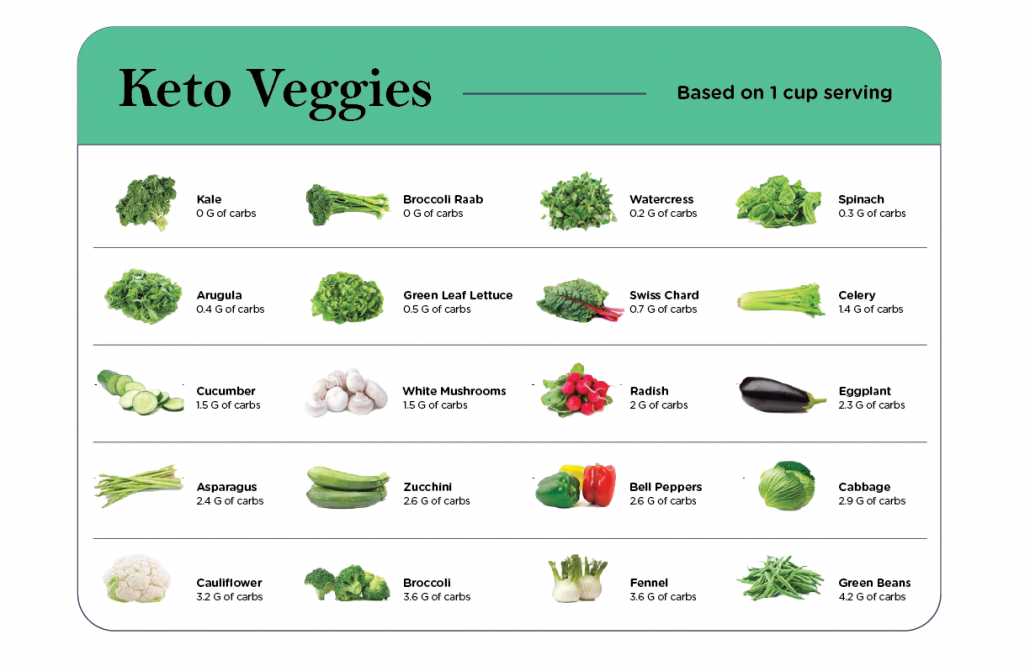
7 Day Keto Sample Menu
Here’s a rundown of what a delicious and nutrient-packed week of keto eating can look like.
Notice that we only suggest two meals per day. When eating over 100 grams of fat per day, meals tend to be much more satiating. Therefore most people need to eat less often. Fewer meals will also allow you to add in the benefits of intermittent fasting.
Day 1
- Avocado collagen smoothie
- Crème fraiche Salmon
Day 2
- Sausage frittata with spinach and mushrooms
- Garlic butter steak with asparagus
Day 3
- Eggs Scrambled with cream cheese, crème fraiche, avocado and pancetta.
- Philly cheesesteak lettuce wraps
Day 4
- Deviled eggs with bacon and cheddar
- Cast Iron Steak with Maitake and Blue Cheese
Day 5
- Bacon and eggs
- Keto pork chops
Day 6
- Stuffed avocados with bacon
- Ribeye and kohlrabi stir fry with toasted walnuts
Day 7
- Sausage egg sandwich with avocado
- Keto chili with guacamole
Ketogenic Diet Side Effects
“Constipation”
For some of us, our digestive systems take time to adjust to an HFLC diet and constipation can show up as a symptom. But it’s probably temporary. You can alleviate constipation by drinking more water, and adding more salt and 200-400 mgs of magnesium citrate daily. If that doesn’t do the trick, there’s Milk of Magnesia,
It’s important to note here that if you’re just pooping less and you don’t feel bloated or abdominal pain, then it’s likely that there’s no issue. Many people report pooping less on an HFLC diet. Part of the reason for this is that you’re giving your body exactly what it needs so there’s not as much indigestible junk for your body to expel.
Keto-Flu
One of the most common side effects when starting out on a keto diet is known as “keto flu.” This collection of flu-like symptoms usually sets in around day 2-4, and can last for up to two weeks. Though for most people it’s just a couple of days.
Symptoms include:
- Headache
- Brain fog
- Constipation
- Diarrhea
- Stomach pain
- Bloating
- Muscle weakness
- Difficulty concentrating
- Fatigue
- Nausea
It is possible for most people to reduce and even avoid most of these symptoms by drinking more water and adding more dietary salt. A lot of these are simply responses to dehydration.
This occurs because when you restrict carbs your insulin levels drop. Less insulin means that your glycogen (the sugar stored in your muscles) gets depleted. Glycogen binds to water and is eliminated in your urine. This is why people tend to urinate a lot when making the transition to keto. So make sure to replace all that water.
Depleted Electrolytes
When you don’t need as much insulin to absorb glucose from your blood, your levels go down, as a result, your body releases excess sodium and other electrolytes.
It is important for your health to replace depleted electrolytes. You can add electrolytes in the following daily quantities:
- 400mg of magnesium citrate
- Potassium from avocados or 2 cups of low-carb leafy greens. Or 1-3 99mg potassium citrate supplements–but more than that will run the risk of heart failure.
- Salt: When in keto you’re losing sodium into the urine, and you’re also likely cutting out processed foods loaded with salt. To rebalance electrolytes many doctors familiar with keto recommend consuming 12 grams, or 2 tsps of salt per day in the first few days of adapting. Once adapted a general recommendation is to consume at least 5 grams, or about 1tsp everyday to avoid headaches, fatigue, and constipation.
One of the most overlooked ways to reduce symptoms is to make sure you’re eating enough fat. For many people the biggest hurdle to a well-formulated HFLC diet is their preconceptions. Getting 70%-80% of your calories from fat can feel extreme at first, but it’s important to give your body all of this powerful macronutrient that it needs.
Ketogenic Diet Risks
For most people, the keto diet appears to be safe.
If you take medications, particularly blood pressure and psychiatric medications, the keto diet can positively alter many of the underlying conditions to the point that medications will need to be adjusted or discontinued.
For these reasons, you and your prescriber will need to monitor your progress as you embark on your keto lifestyle.
Is the Ketogenic Diet Sustainable?
Keto is radically different from the Standard American (Western) Diet. For this reason, it is often seen as extreme and unsustainable.
However, eating keto aligns with how humans are evolved to eat. When viewed in the context of human evolution, diets high in plant-based carbs and processed foods are the truly extreme departure from our natural dietary norms.
When viewed from an evolutionary historical perspective, it’s not surprising that studies support long-term keto.
A study looking at long-term keto for the treatment of obesity found many beneficial effects including significantly reduced body weight, decreased levels of triglycerides, LDL cholesterol, and blood glucose, and increased levels of HDL (good) cholesterol.
Sticking with keto long-term may be critical to your health and longevity. Long term keto is used to treat health issues like epilepsy, combat neurodegenerative diseases like Alzheimer’s or Parkinson’s, balance chronic mood disorders, and reduce inflammatory diseases like PCOS and osteoporosis
For people with no apparent health issues, practicing long-term, but less strict high-fat low-carb diets may feel easier to sustain. Cyclical keto can help your body recalibrate hormone imbalances and inflammatory patterns.
The Takeaway
Ketogenic diets provide many health benefits, especially for people suffering from health issues related to blood sugar and insulin resistance. They are excellent for weight loss, treating diabetes and cancer, reducing cardiovascular risk factors, and alleviating the symptoms of neurological disease.
The foods the diet allows are delicious and satisfying, side effects are minimal and easily overcome, and the overall health benefits are overwhelmingly positive. You will look better and feel better. What’s not to like?













